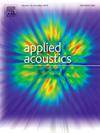Low-frequency sound absorption enhancement in multi-layer honeycomb metamaterials with embedded long-curved-neck Helmholtz resonators
IF 3.4
2区 物理与天体物理
Q1 ACOUSTICS
引用次数: 0
Abstract
To overcome the narrow absorption bandwidth of conventional Helmholtz resonator-based acoustic metamaterials in the low-frequency range, this study proposes a multi-layer honeycomb acoustic metamaterial with embedded long-curved-neck Helmholtz resonators (ELCN-HR). A comprehensive methodology integrating theoretical analysis, numerical simulations, and experimental testing is employed to systematically investigate the modulation of resonance frequency by neck geometric parameters and the multi-resonance mode superposition mechanism induced by hierarchical coupling. The results show that the micro-perforation diameter contributes the most in all parameters. Furthermore, the elongated ELCN-HR design substantially reduces resonance frequencies while improving acoustic wave dissipation efficiency. Additionally, the multi-layered coupling architecture excites localized resonance peaks across adjacent frequency bands, facilitating continuous spectral coupling. Optimized simulations demonstrate that the proposed metamaterial achieves a half-absorption bandwidth of 448 Hz (285–733 Hz), representing a 32% enhancement compared to conventional single-layer Helmholtz coupled structures (340 Hz). Moreover, the onset frequency for α > 0.5 is reduced from 720 Hz to 285 Hz, significantly extending low-frequency absorption performance. Mechanistic analysis confirms that multi-scale acoustic impedance gradient matching plays a critical role in enhancing broadband energy dissipation. These findings provide a novel design paradigm for developing low-frequency broadband sound-absorbing metamaterials.
嵌入长曲颈亥姆霍兹谐振腔的多层蜂窝超材料低频吸声增强研究
为了克服传统基于亥姆霍兹谐振器的声学超材料在低频范围内吸收带宽狭窄的问题,本研究提出了一种嵌入长曲颈亥姆霍兹谐振器(ELCN-HR)的多层蜂窝状声学超材料。采用理论分析、数值模拟和实验测试相结合的综合方法,系统地研究了颈部几何参数对谐振频率的调制和层次耦合引起的多共振模式叠加机制。结果表明,微射孔直径在各参数中贡献最大。此外,细长的ELCN-HR设计大大降低了共振频率,同时提高了声波耗散效率。此外,多层耦合结构激发了相邻频段的局部共振峰,促进了连续的频谱耦合。优化的仿真结果表明,所提出的超材料实现了448 Hz (285-733 Hz)的半吸收带宽,比传统单层亥姆霍兹耦合结构(340 Hz)提高了32%。此外,α >;0.5从720 Hz降低到285 Hz,显著延长低频吸收性能。力学分析证实了多尺度声阻抗梯度匹配在增强宽带能量耗散中起着关键作用。这些发现为开发低频宽带吸声超材料提供了一种新的设计范式。
本文章由计算机程序翻译,如有差异,请以英文原文为准。
求助全文
约1分钟内获得全文
求助全文
来源期刊

Applied Acoustics
物理-声学
CiteScore
7.40
自引率
11.80%
发文量
618
审稿时长
7.5 months
期刊介绍:
Since its launch in 1968, Applied Acoustics has been publishing high quality research papers providing state-of-the-art coverage of research findings for engineers and scientists involved in applications of acoustics in the widest sense.
Applied Acoustics looks not only at recent developments in the understanding of acoustics but also at ways of exploiting that understanding. The Journal aims to encourage the exchange of practical experience through publication and in so doing creates a fund of technological information that can be used for solving related problems. The presentation of information in graphical or tabular form is especially encouraged. If a report of a mathematical development is a necessary part of a paper it is important to ensure that it is there only as an integral part of a practical solution to a problem and is supported by data. Applied Acoustics encourages the exchange of practical experience in the following ways: • Complete Papers • Short Technical Notes • Review Articles; and thereby provides a wealth of technological information that can be used to solve related problems.
Manuscripts that address all fields of applications of acoustics ranging from medicine and NDT to the environment and buildings are welcome.
 求助内容:
求助内容: 应助结果提醒方式:
应助结果提醒方式:


